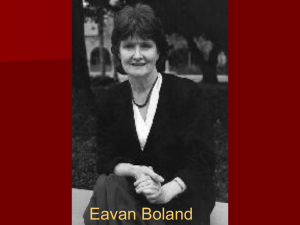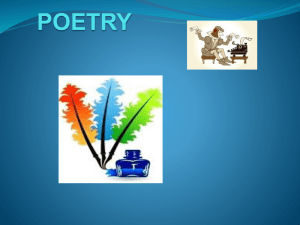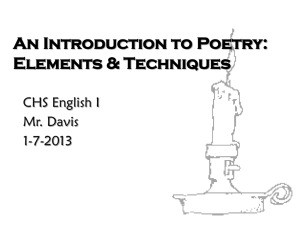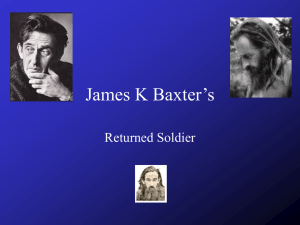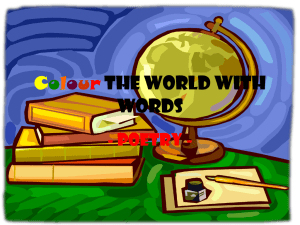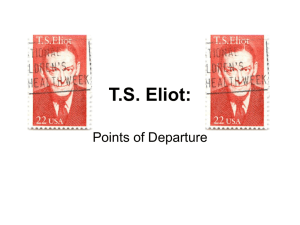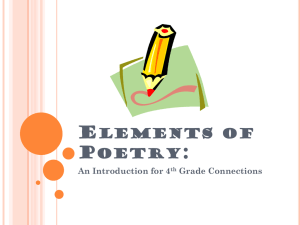Poems and Prose EDI - Pacoima Charter School
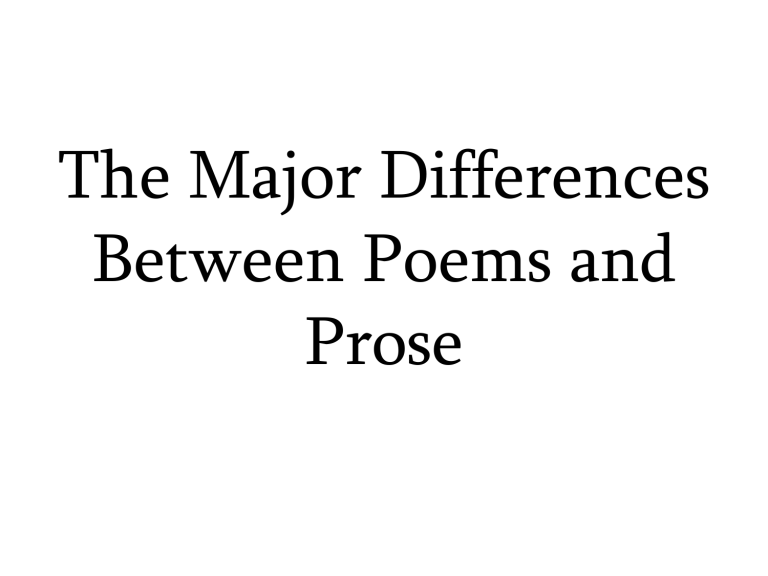
The Major Differences
Between Poems and
Prose
CCSS 4RL.5
Explain major differences between poems, drama, and prose, and refer to the structural elements of poems (e.g. verse, rhythm, meter) and drama (e.g., casts of characters, settings descriptions, dialogue, stage directions) when writing or speaking about a text.
Learning Objective
• Today we will learn the elements of and explain the difference between, poems and prose.
• What are we going to explain the difference between?
• (partner share)
Have you ever read a Dr. Suess story?
• Share with your partner a Dr. Suess story that you remember.
• Most Dr. Suess stories are an example of rhyming poetry. Click on this link
• Read some Dr. Suess
Poetry’s Purpose
•
Poetry is a form of writing that is meant to
1. entertain
2. describe
3. inform
4. persuade
Elements of Poetry
•What is poetry?
•Poetry is not prose. Prose is the ordinary language people use in speaking or writing.
•Poetry is a form of literary expression that captures intense experiences or creative perceptions of the world in a musical language.
•Basically, if prose is like talking, poetry is like singing.
•By looking at the set up of a poem, you can see the difference between prose and poetry.
Distinguishing Characteristics of Poetry
• Prose has a
poetry has a speaker.
– A speaker , or voice, talks to the reader. The speaker is not necessarily the poet. It can also be a fictional person, an animal or even a thing
Green Eggs and Ham
Do you like green eggs and ham?
I do not like them, Sam-I-am.
I do not like green eggs and ham!
Would you like them here or there?
I would not like them here or there.
I would not like them anywhere.
I do so like green eggs and ham!
Thank you! Thank you,
Sam-I-am!
Poetry is written in lines and stanzas
• A line is just one line of writing.
• A stanza is a group of lines separated by a space from another group of lines.
• Read the following slide to understand the difference between lines and stanzas.
I Love To Write Poems (title)
• (First Stanza)
• I love to write Day and night
• What would my heart do
• But cry, sigh and be blue
• If I could not write
• (Second Stanza)
• Writing feels good
• And I know it should
• Who could have knew
• That what I do
• Is write, write, write-
• Unknown Author
A line in the poem
A stanza
Figures of Speech
• A figure of speech is a word or expression that is not meant to be read literally.
• BOTH PROSE AND POETRY USE FIGURES OF
SPEECH
• A simile is a figure of speech using a word such as like or as to compare seemingly unlike things.
Example
Does it stink like rotten meat?
from “Harlem” by Langston Hughes
Figures of Speech
• A metaphor also compares seemingly unlike things, but does not use like or as.
You might be a doorknob!
Or three baked potatoes!
You might be a bag full of hard green tomatoes. (Happy Birthday by Dr. Suess)
• Personification attributes human like characteristics to an animal, object, or idea.
Example
A Spider sewed at Night from “A Spider sewed at Night” by Emily Dickinson
Figures of Speech
•
• Hyperbole – a figure of speech in which great exaggeration is used for emphasis or humorous effect.
Example
“You’ve asked me a million times!”
Imagery is descriptive language that applies to the senses – sight, sound, touch, taste, or smell. Some images appeal to more than one sense.
Sound Devices
•
•
•
Alliteration is the repetition of consonant sounds at the beginning of words.
Assonance is the repetition of vowel sounds within a line of poetry.
Onomatopoeia is the use of a word or phrase, such as “hiss” or “buzz” that imitates or suggests the sound of what it describes.
BOTH POETRY AND PROSE USE SOUND DEVICES
Example of Sound Devices
• Betty Botter by Mother Goose
• Betty Botter bought some butter, but, she said, the butter’s bitter; if I put it in my batter it will make my batter bitter, but a bit of better butter will make my batter better.
• So she bought a bit of butter better than her bitter butter, and she put it in her batter and the batter was not bitter. So ’twas better Betty Botter bought a bit of better butter.
• THIS IS ALLITERATION
Example of Sound Devices
• Onomatopoeia (by Eve Merriam)
• The rusty spigot sputters, utters a splutter, spatters a smattering of drops, gashes wider; slash splatters scatters spurts finally stops sputtering and plash!
gushes rushes splashes clear water dashes.
Poems break grammar rules
The rusty spigot sputters, utters a splutter
Each line does not have to begin with a capital letter or be a complete sentence.
THIS MAKES
POEMS VERY
DIFFERENT
FROM PROSE.
Rhyme
•
•
•
•
Rhyme is the repetition of the same stressed vowel sound and any succeeding sounds in two or more words.
Internal rhyme occurs within a line of poetry.
End rhyme occurs at the end of lines.
Rhyme scheme is the pattern of end rhymes that may be designated by assigning a different letter of the alphabet to each new rhyme
BOTH POEMS AND PROSE CAN USE RHYME
BUT IT IS MOST CLOSLEY CONNECTED TO POEMS
Example
“All mine!" Yertle cried. "Oh, the things I now rule!
I'm king of a cow! And I'm king of a mule!
I'm king of a house! And what's more, beyond that,
I'm king of a blueberry bush and cat!
I'm Yertle the Turtle! Oh, marvelous me!
For I am the ruler of all that I see!”
B
B
A
A
C
C
A couplet
• In poetry, a couplet is a pair of lines. Typically, they rhyme and have the same meter. They make up a unit or complete thought.
“All mine!" Yertle cried. "Oh, the things I now rule!
I'm king of a cow! And I'm king of a mule!
Rhythm and Meter
• Rhythm is the pattern of sound created by the arrangement of stressed and unstressed syllables in a line.
• Meter is a regular pattern of stressed and unstressed syllables which sets the overall rhythm of certain poems.
Listen to the rhythm in this Shel
Silverstein poem
• I Don’t Know
• I don’t know how anythings’ done.
• Does the earth turn or is it the sun?
• Is electricity made by a kite?
• Are star twinkles just the reflection of light?
• How thunder is made and how engines run
• I don’t know how anything’s done
READ IT AGAIN AND CLAP YOUR HANDS WITH THE RHYTHM.
Elements of Poetry: Tone and Mood
Although many times we use the words mood and tone interchangeably, they do not necessarily mean the same thing.
Mood – the feeling or atmosphere that a poet creates. Mood can suggest an emotion (ex. “excited”) or the quality of a setting (ex. “calm”, “somber”) In a poem, mood can be established through word choice, line length, rhythm, etc.
Tone – a reflection of the poet’s attitude toward the subject of a poem. Tone can be serious, sarcastic, humorous, etc.
Forms of Poetry
•
Poetry can take several forms. These are:
Forms of Poetry
1. Shape Poems
2. Acrostic Poems
3. Ballads
4. Lyrical Poems
5. Haikus
6. Narrative Poems
7. Free Verse
8. Blank Verse
Shape Poem
Narrative Poetry
• Narrative poetry is verse that tells a story.
• Two of the major examples of narrative poetry include:
– Ballads – a song or poem that tells a story.
Folk ballads, which typically tell of an exciting or dramatic event, were composed by an anonymous singer or author and passed on by word of mouth for generations before written down. Literary ballads are written in imitation of folk ballads, but usually given an author.
– Click on this link to hear the folk ballad
“Casey Jones”
– Epics – a long narrative poem on a great and
Dramatic Poetry
• Dramatic poetry is poetry in which one or more characters speak.
– Each speaker always addresses a specific listener.
– This listener may be silent (but identifiable), or the listener may be another character who speaks in reply.
– Usually the conflict that the speaker is involved with is either an intense or emotional.
Haikus
• The traditional Japanese haiku is an unrhymed poem that contains exactly 17 syllables, arranged in 3 lines of 5, 7, 5 syllables each.
• However, when poems written in Japanese are translated into another language, this pattern is often lost.
• The purpose of a haiku is to capture a flash of insight that occurs during a solitary observation of nature.
The moon is a week old -
A dandelion to blow
Scattering star seed.
(Ruby Lytle)
Free Verse
• Free verse is poetry that has no fixed pattern of
meter, rhyme, line length, or stanza arrangement.
• When writing free verse, a poet is free to vary the poetic elements to emphasize an idea or create a tone.
• In writing free verse, a poet may choose to use repetition or similar grammatical structures to emphasize and unify the ideas in the poem.
Free Verse
“Tell Me” by Shel Silverstein
• Tell me I’m clever,
• Tell me I’m kind,
• Tell me I’m talented,
• Tell me I’m cute,
• Tell me I’m sensitive,
• Graceful and wise,
• Tell me I’m perfect,
• But tell me the truth
Free Verse
• While the majority of popular poetry today is written as free verse, the style itself is not new. Walt
Whitman, writing in the 1800’s, created free verse poetry based on forms found in the King James Bible.
• Modern free verse is concerned with the creation of a brief, ideal image, not the refined ordered (and artificial, according to some critics) patterns that other forms of poetry encompass.
• Follow this link to an example of Free Verse
Prose’s Purpose
•
Prose is a form of writing that is meant to:
1. inform
2. entertain
3. persuade
4. describe
Text Features of Prose
•
There are several features of prose that make it unique from other forms of writing. These are:
Text Features of Prose
1. Written using paragraphs
2. Contains dialogue
3. Can be either fiction or nonfiction
4. Can have headings and/or subheadings
5. Can be complemented by graphics
(charts, photos)
Forms of Prose
•
Prose can take several forms. These are:
Forms of Prose
1.
Biography
2. Autobiography
3.
Essay
4. Novel
5.
Short Story
6. Novella (short story)
7. Article
8. Fable / Folktale
9. Folktale
Click on links to see examples online.
A narrator is a person
• Who is telling the story
To Sum it up!
Poems have:
• Rythmn /rhyme schemes
• Meter
• Verses
• Stanzas
• Lines
• Breaks grammar rules
• Voice/speaker
• Mood
• couplets
Prose has:
• Characters
• Narration
• Paragraph
• Follows grammar rules
• Chapters
• Headings/titles/subtitles
• Point of view
• Setting
• Plot
• Voice

